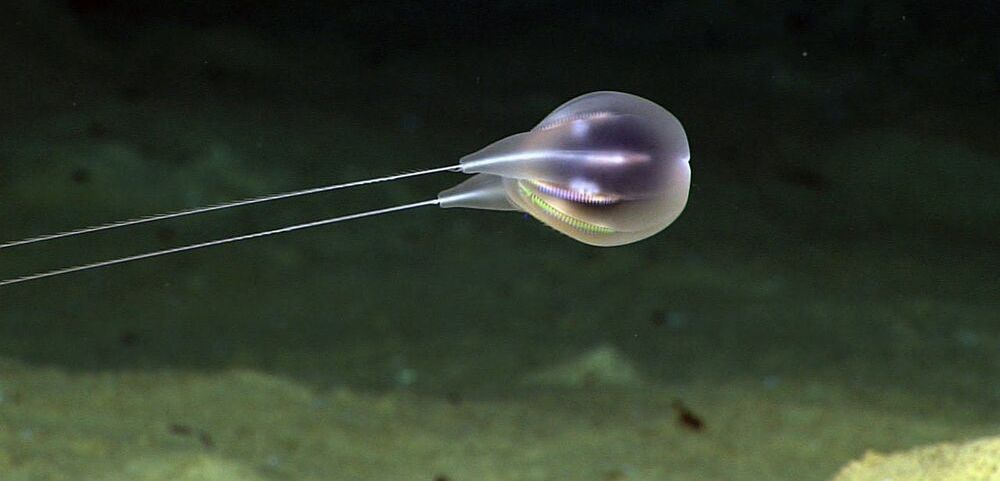Nov 30, 2020
Man With Bionic Arm Shows How He Lives
Posted by Raphael Ramos in categories: cyborgs, transhumanism
Henrik shows off his bionic arm! 😃
Henrik shows how he performs everyday tasks with a bionic arm 😮 🦾.
Henrik shows off his bionic arm! 😃
Henrik shows how he performs everyday tasks with a bionic arm 😮 🦾.
Video. Well, at least the planet/environment benefits somewhat from what’s currently happening.
Maybe we can continue the good while overcoming the bad?
Pandemic restrictions reduced global nitrogen dioxide concentrations by nearly 20%, NASA finds.

For the first time, scientists with the National Oceanic and Atmospheric Administration (NOAA) have formally identified a new species of undersea creature based solely on high-definition video footage captured at the bottom of the ocean.
And what an undersea creature it is. Meet Duobrachium sparksae – a strange, gelatinous species of ctenophore, encountered by the remotely operated vehicle (ROV) Deep Discoverer during a dive off the coast of Puerto Rico.
The Army Research Office has pledged $6.25 million towards developing mindreading technology for use on the battlefield.
Faster, smaller, smarter and more energy-efficient chips for everything from consumer electronics to big data to brain-inspired computing could soon be on the way after engineers at The University of Texas at Austin created the smallest memory device yet. And in the process, they figured out the physics dynamic that unlocks dense memory storage capabilities for these tiny devices.
The research published recently in Nature Nanotechnology builds on a discovery from two years ago, when the researchers created what was then the thinnest memory storage device. In this new work, the researchers reduced the size even further, shrinking the cross section area down to just a single square nanometer.
Getting a handle on the physics that pack dense memory storage capability into these devices enabled the ability to make them much smaller. Defects, or holes in the material, provide the key to unlocking the high-density memory storage capability.
Since Xi put out the call to build up the new area, China’s tech giants have piled in. Alibaba Group Holding, Tencent Holdings, Baidu, Zhongguancun Science Park and Tsinghua University have all established projects in Xiongan. The projects include the use of sensors, 5G networks and facilities for supercomputing and big data in the pursuit of building up the smart city. Alibaba is the parent company of the Post.
JD Digits, the e-commerce giant’s big data arm, is building a smart city operating system that uses artificial intelligence for urban management.
A Singaporean mom who beat COVID-19 while pregnant has given birth to a baby with antibodies against the virus, according to a report.
Celine Ng-Chang, 31, gave birth this month to the baby boy, who tested negative for the virus but did have the antibodies, the Straits Times reported.
“My doctor suspects I have transferred my COVID-19 antibodies to him during my pregnancy,” she told the newspaper.
Scientists at Osaka University develop a label-free method for identifying respiratory viruses based on changes in electrical current when they pass through silicon nanopores, which may lead to new rapid COVID-19 tests.
The ongoing global pandemic has created an urgent need for rapid tests that can diagnose the presence of the SARS-CoV-2 virus, the pathogen that causes COVID-19, and distinguish it from other respiratory viruses. Now, researchers from Japan have demonstrated a new system for single-virion identification of common respiratory pathogens using a machine learning algorithm trained on changes in current across silicon nanopores. This work may lead to fast and accurate screening tests for diseases like COVID-19 and influenza.
In a study published this month in ACS Sensors scientists at Osaka University have introduced a new system using silicon nanopores sensitive enough to detect even a single virus particle when coupled with a machine learning algorithm.
As the Signal protocol becomes the industry standard, it’s worth understanding what sets it apart from other forms of end-to-end encrypted messaging.
The tech giant Google has announced they will begin accepting Google Learning Certificates in place of college degrees, offering six-month courses for prospective employees to train for in-demand jobs in a fraction of the time it would take at University. The qualification will see successful students graduate with a Google Career Certificate, which will be viewed by the company as the equivalent of a four-year degree for similar roles.
